COLUMNS
ARTI-PHYSIS
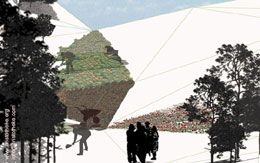
5 September, 2008
FRAGMENTARY IMPUNITIES > VALLADOLID TRAJECTORIES (PART A')
At first view, the Las Raposas site appears as a non-urban underdeveloped zone with poor influences from the surrounding environment.
Not an agricultural plot, not natural either, partially neglected and occasionally used as a landfill, this blank slate appears as an ideal tabula rasa terrain. Still, in a more detailed examination of the urban and infrastructural information, the context of this locale re-merges as an exuberant sampling, an amazing manifestation of intricate and uncanny species of massive urbanization.
EUROPAN 8 ARCHITECTURAL COMPETITION ENTRY, FALL 2005
PART A'
INTRODUCTION: This project is a Europan 8 competition entry. Team creadits: teamleader Aristotelis Dimitrakopoulos [architect], collaborators: Rebecca Morgan, Diana Stacey, Megan Storm and Jennifer Williams [architecture students].
MOTOR-TOPIA: As a huge irony or as specimen of a fast-approaching future, an urban explosion amidst rural land, the roadway system appears as collaged from another, severely capitalist context; anticipating a city yet to come. Highway infrastructure that could possibly support a dense, massive urban sector exists at a locus of almost purely rural character. Hausmannesque, almost Parisian 8-story or taller residential buildings line the boundaries of superblocks shaped as avoiding the almost anti-urban motorways that reflect their utilitarian, infrastructural qualities.
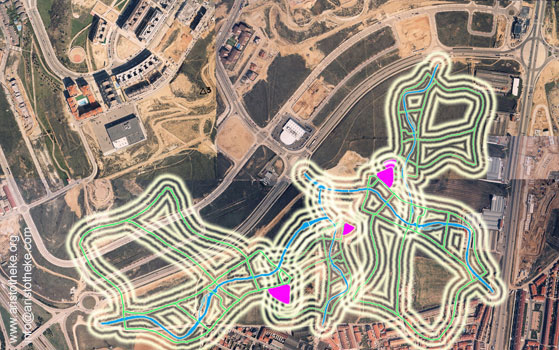
ORGASMIC URBANIZATION: There are only extreme antitheses and clear intentions apparent around this site: either nothingness, intact nature, or city-dense linear residential slabs; city architecture without a city; an urban joke of closely collaged building typologies with absolutely no relevance or interrelation, both in architectural as much as in market or real-estate terms; unique urban constellations at [seemingly] a non-place manifesting a European post-suburban jungle. This is a sampling of experimental yet market-driven mass housing prototypes and a testing ground for extreme adjacencies between logistics and housing.
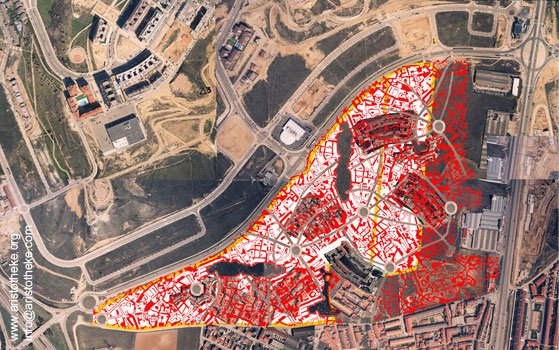
IMAGERY: The private water pools and sports facilities portray the communal yet privatized civic character of the tall residential complexes as much as the linear single-residence enclaves. Promenades, tree-lined malls and public squares reflect an intention to create a pedestrianized world separated from the traffic arteries. Industrial sheds, junk-yards and machinery yards butt up against high-end residential development, generating a unique prototype advancing the extremities of the American reality to a new status of hype urbanism. Logistics are found next door to housing with no interim gaps, patches of nature or junkyards and waste areas. This closeness of antithetical conditions indeed does resolve the inertias of western urbanism where everything is simply floating in a totally unresolved manner in the ample expanses of available and degraded land.
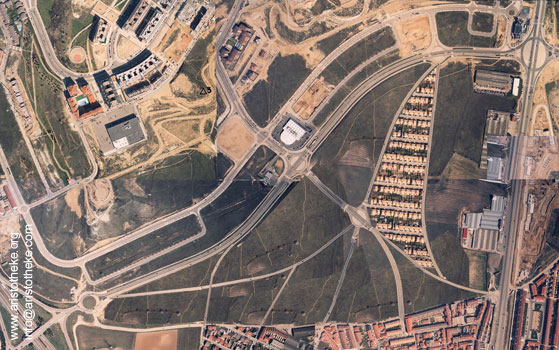
HOUSING PARANOIA: depicted clearly in the samples of urban typologies isolated from the aerial photographs of the site [see presentation], this is a surreal diversity and spectrum of housing typologies and planning modes - seemingly belonging to radically differentiated economic scenaria - in very close proximity from one another. Ranging from sectors of generic suburbia to blocks of almost city-center complexity, unique intermediate versions of urbanism become here reality. Rowhouses generated by colliding suburban homes, taller linear forms of housing; detached high-rise buildings; commercial sectors of American-type shopping malls; freestanding, isolated super-block structures organized around atria, floating in the open landscape and not particularly synchronized in their siting; rowhouses that span whole blocks, positioned in more organized urban grid systems, ranging from single-residence units to multi-storied complexes;
sequential syntheses of duplexes or triplexes [linear rows] with heightened densities, generating quasi-campus effects and simultaneously composing street frontages; detached or semi-detached single residences of suburban ethic with front and back-yard hierarchies, identical and homogenized; downtown-quality linear and tall [often 8-storied] apartment blocks appearing as removed from the Hausmannian districts of Paris or from the Historic Center of Barcelona; freestanding high-rise housing tower-like assemblies organized around central open spaces. Even if the new wave of growth is still in progress with many zones under construction, the presence of mass development becomes evident, while the attention to public and common-use areas prevails through a clear definition of paved open squares, easily distinguished in the aerial view.
CLOSE KNITTING: This tight collage of incredibly diverse samples demonstrates an intricate advanced version of commercial European urbanism, set in opposition to the equivalent American phenomena. This comparison and the differentiation with the western reality emerges primarily because of the increased “muscularity” and the scale of experimentation. Drastically opposing urban directives in such close proximity appear as attempting to break in and invade each other’s market rules. Replicating an urban imagery that corresponds more to Far-East economic booms than to European realities, sports facilities, artificial green areas, private pools and paved civic areas of heightened monumentality emerge from nowhere.
This unique amalgam of contrasting urbanities becomes even more controversial through the presence of isolated small industrial units within the residential fabric, the presence of larger shopping center [mall] facilities replicating their American counterparts and of course the larger automotive industry campuses.
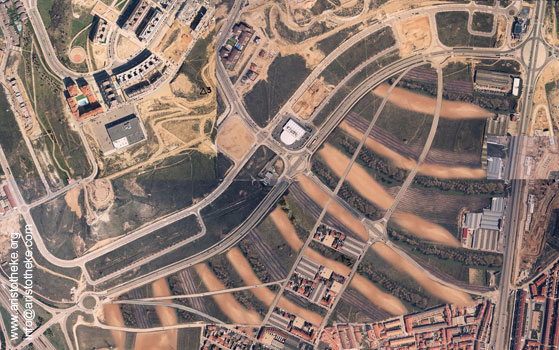
MEDIEVAL MODE: These contemporary species of development, young and abrupt in many ways, share boundaries with the more settled and calm urban sectors south from the intervention zone, where a traditional village-like density is achieved through the homogenous fabric of low-rise residential units of quasi- heterogeneous and seemingly unforced aesthetics [vernacular perhaps] clearly not mass-produced and with a randomized street pattern. The edge of this community, a sharp straight line, appears as totally unnatural, offering a possibility for the release of the growth potential and the extension of the existing urban
axes into the new site.
INTRICATE ADJACENCIES: This prototypical context offers strong ground for the development of tighter and elaborately scaled mixes of uses. The automotive industries of the area are the very reason for its growth. The first steps are already evident in the direction of identifying and showcasing the workplace beyond the purely utilitarian and banal reality of survival or, even worse, profiteering. More direct and powerful links are already established between the residential quarters and the industry bringing the campus enclaves into the urban fabric. This directive arises as a unique potential focus for the new district.
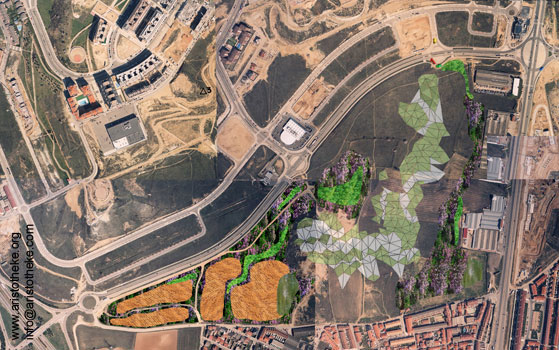
PRODUCE/LIVE MODE: As a response to the phenomenon of linear industrial sheds intruding into the regular habitation fabric, the model that was first studied was a provocative industry/housing model elaborating on the current contextual qualities of very close proximity between diverse typologies. This is apparent in one of
the aerial collages onto the site, where new blocks relate to the size-wise comprehensive village pattern south of the site, comprising housing, urban voids/squares and light industry into one system, avoiding larger zoning differentiations.
REPOSE: In relation to the scale of the intervention zone, in this plateau of incredible urban innovation showcasing a total denial towards any kind of connective tissue [a site in any case with strong evidence for the potential of urban synergies] the project shifted towards a more haptic approach to the contextual intricacies. The particular intervention area is a raised terraced landscape that faces the river, inherently defining the transition between residential and industrial sectors.
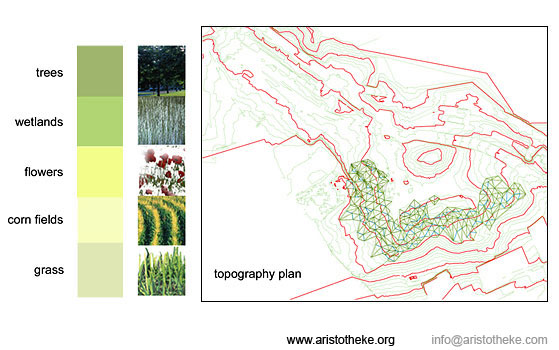
PRE-HISTORY: Examining the soil characteristics and partially the historical traces of the area and the region, hollowness and below-ground habitation emerged as promising directives of examination. Breaking further the boundaries of generic speculative development, archetypes of primitive and nomadic dwelling were retested.
Aristotelis Dimitrakopoulos.
Related articles:
- HORROR VACUI: JOSTLE, HUDDLE AND HELLENIC MODERNITY ( 21 June, 2005 )
- ATTIC ECTOPIA ( 16 November, 2012 )
- FRONTAGE SHOWCASES AND THE POST-URBAN UNCANNY-A RECTROACTIVE MANIFESTO FOR HELLENIC PROFESSIONAL SPACES ( 01 January, 2010 )
- VI: Unrecycling Cyclades. Part 1 ( 04 October, 2010 )
- Gwangju Asian Cultural Center, Korea – International Competition Entry, October ( 7 December, 2007 )
- De-institutionalizing Education: Notes on Academic Initiatives(i) ( 7 July, 2007 )
- HARBORING CAR-BAN-ITIES [Port Nord Organizational Protocols] ( 8 October, 2007 )
- Stratifying Axialities> Celadina ReCelled (PART A) ( 14 March, 2008 )
- Stratifying Axialities> Celadina ReCelled (PART B) ( 11 April, 2008 )
- FRAGMENTARY IMPUNITIES > VALLADOLID TRAJECTORIES (PART B') ( 5 November, 2008 )
- SUBTERRA * SUPRATERRA ( 22 May, 2009 )
- VI: Unrecycling Cyclades. Part 2 ( 14 October, 2010 )
- Translocality as a Post-Native Narrative ( 16 February, 2011 )
- Metaxekisis : Re-Thinking the Athenian Court ( 08 December, 2010 )
- L-I*-THEKE ( 02 April, 2013 )
- House - glyptotheque - gallery - workshop ( 19 July, 2013 )
- Piloting Pilotis ( 31 December, 2013 )
- Escalteca of the Choetheque Series ( 01 April, 2014 )
- Schottheke of the Choetheque Series ( 01 June, 2014 )
- Floatheca Rh of the Choetheque Series ( 01 August, 2014 )
- Floatheca Sp of the Choetheque Series ( 26 September, 2014 )
- O-theke of the Choetheque Series ( 11 March, 2015 )
- Floatheca Cy of the Choetheque Series ( 03 January, 2015 )
- Ophthalteca ( 24 June, 2015 )
- Y-theca of the Choetheque Series ( 08 October, 2015 )










